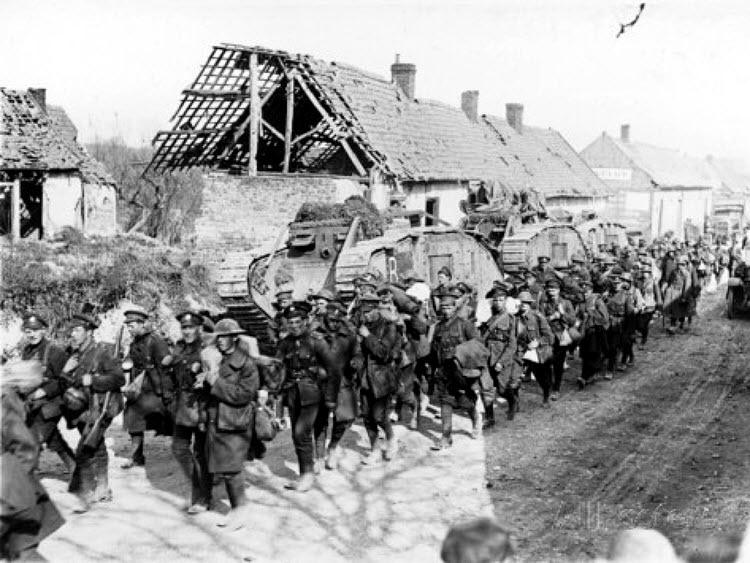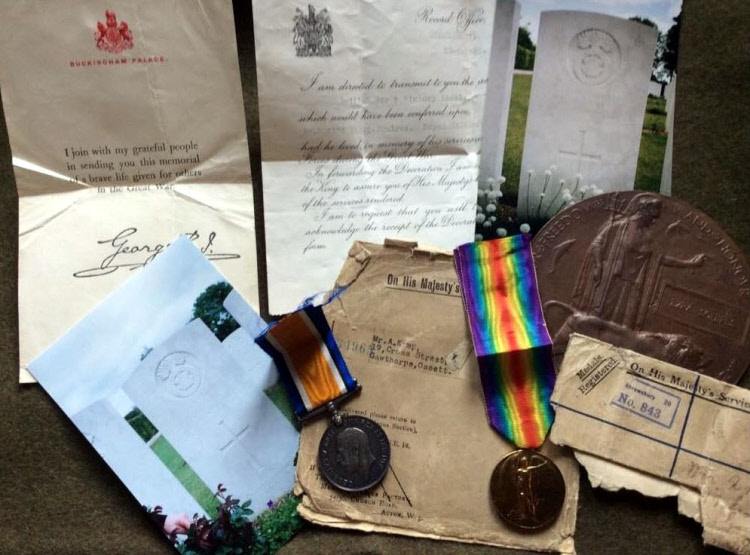
202184, Royal Welsh Fusiliers, 1/4th Pioneer Battalion
Ezra Squires was born in Ossett in 1897, but was registered as Ezra Squires Spurr in the BMD register. In 1901, aged 4, he was living in Cross Street, Gawthorpe, Ossett with his father John Squires, a coal miner and living with them was widow Sarah Spurr, shown in the census as a servant. She was born Sarah Walker Kemp in 1862 and in 1879, a Harvey Spurr married a Sarah Kemp at Wakefield. Harvey Spurr died aged 67 in 1923 at Wakefield suggesting the couple had parted and that Sarah moved in with with John Squires. It is assumed therefore that Sarah Spurr was Ezra’s mother. There were three other siblings, two sons and a daughter with the surname Spurr, but all shown as John Squires’s children.
In 1891, Sarah Spurr is living on Jack Lane, Ossett with her father Ezra Kemp (65), a retired Soldier and his putative wife Sarah Ann. In the household is Ezra’s daughter, Sarah Kemp and 3 year-old Allen Spurr. In 1881, Ezra Kemp is working as a rag dyer and is living with Sarah Ann in Ossett. In the household is a Sarah Kemp and she is recorded as married, but she has no children and isn’t calling herself Spurr.
In 1911, the Squires family are living in a two-roomed house in School Street, Gawthorpe. John Squires (56), a corporation labourer is the head of the household and Sarah Spurr (49) is now described as Sarah Squires. The children were Dick Squires (17), a pony driver, underground miner; Ezra Squires (14), also a pony driver, underground miner; Lydia Squires (11), at school and Allan Squires (23), a domestic groom.
It is likely that Ezra joined the army in 1915. He initially joined the Miners’ Battalion, the 12th Battalion, KOYLI, and was given the regimental number 2045. It is likely therefore that he worked as a miner prior to enlisting. Ezra Squires was destined not to stay with the Miners’ Battalion, instead being transferred to the Royal Welsh Fusiliers, joining the 4th Battalion which was the pioneer battalion to the 47th (2nd London) Division.
In early April 1918, the battalion was at Senlis, a village 3½ miles north-west of Albert. Based in the village chateau, it was providing working parties in the front line at the village of Bouzincourt. On 4 April the battalion was unexpectedly given a rest from its normal duties in order to recuperate prior to going up to the front line where the men were to be used as infantry. At 1pm on 5 April, the battalion was ordered up to the front line, to take up position at a crossroads between the villages of Bouzincourt and Martinsart. Placed under the orders of 142 Brigade, the battalion was told it would be delivering a counter-attack against the Germans.
In moving into position north-west of Martinsart, the battalion suffered three other ranks killed, plus sixteen wounded. The battalion’s War Diary describes how, by 4am on 6 April, two of the battalion’s three companies (‘A’ and ‘B’ companies) were:
“…assembled for the attack along the bank to the west of Aveluy Wood….‘B’ on the right, ‘A’ on the left….companies advanced in extended order to the edge of the wood where snake formations were adopted. Zero hour was fixed [for] 5.55am. The attack failed owing to the intensity of the hostile machine gun fire and the inefficiency of our own artillery barrage. Having sustained very heavy casualties ‘B’ Company fell back to their original line….[a] machine gun was silenced in the wood by bombing and killing the crew. The position was held and consolidated. As the other machine guns were out of bombing distance, no further advance could be made….At 7pm before the relief took place a violent enemy barrage was put down behind our front line and on the village of Martinsart lasting 20 minutes….Thus ended the most disastrous day in the history of the battalion.”
The battalion and the rest of 142 Brigade were relieved that night. The battalion’s War Diary lists casualties as:
“7 officers and 15 other ranks killed, 1 officer and 1 other rank died of wounds, 2 officers and 71 other ranks wounded, 10 other ranks gassed, 49 other ranks missing.”
Of the 65 other ranks killed, died of wounds or missing, “Soldiers Died in the Great War” gives a figure of 40 men killed in action or died of wounds on this day. Of these 40 men, eight had formerly been with the KOYLI, their regimental numbers indicating that, like Ezra Squires, they were drafts from the 12th (Miners’) Battalion.
One of those killed on the 6th April 1918 was Private Ezra Squires, who died aged 21. His next of kin was given as his brother Allan Kemp, of 19, Cross St., Gawthorpe, Ossett, Yorks. Allan Kemp was actually Ezra Squires Spurr half-brother and his birth registration was in the name of Allan Spurr. Private Squires’s service record has not survived, but he was awarded the British and Victory Medals posthumously.

Above: British soldiers and tanks at Aveluy village in 1918.
Private Ezra Squires (Spurr) is buried at grave reference G. 2. at the Hedauville Communal Cemetery Extension 2, Hedauville, Somme, France. Hedauville is approximately 5 kilometres north-west of Albert, on the road to Doullens.
The extension was begun at the end of March 1918, when the front line was consolidated a short distance east of the village following the German offensive. It was used by field ambulances and fighting units until the following August. The extension contained 95 graves at the Armistice, but was later increased when graves were brought in from the surrounding battlefields of March-August 1918. There are now 178 First World War burials in the extension and two from the Second World War. Additional Information: Brother of Allan Kemp, of 19, Cross St., Gawthorpe, Ossett, Yorks.

Above: In 2015, Private Ezra Squires’s WW1 war medals were put up for auction on eBay at a starting price of £260. The medals and the documentation from WW1 can be seen above.
References:
1. “A Village Goes to War: A History of the Men of Ravensthorpe who fell in the Great War”, by David Tattersfield, Published by Barkers Trident Communications (2001), ISBN 10: 0953468933